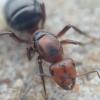Formica has the advantage that they stay relatively small, Lasius niger can top out at 50000+ workers.
- Formiculture.com
- Forums
- Gallery
- Members
- Member Map
- Chat

Formica has the advantage that they stay relatively small, Lasius niger can top out at 50000+ workers.
We should respect all forms of consciousness. The body is just a vessel, a mere hull.
Welcome to Lazy Tube - My Camponotus Journal
I don't think formica can do that 90º thing. I am not sure about Aphaenogaster though.
Aphaenogaster cf. rudis
Tetramorium immigrans
Tapinoma sessile
Formica subsericea
Pheidole sp.
Camponotus nearcticus
Formica has the advantage that they stay relatively small, Lasius niger can top out at 50000+ workers.
I didn't know Lasius Niger can get to 50,000 workers. Are you sure?
Aphaenogaster cf. rudis
Tetramorium immigrans
Tapinoma sessile
Formica subsericea
Pheidole sp.
Camponotus nearcticus
I'm pretty sure that all ants can climb corners with rubber or caulk if there is not an adequate barrier. As long as there is a barrier then I wouldn't worry about either species escaping. I recommend using olive oil as a barrier.
I accidentally froze all my ants
Wait, is olive oil a good barrier? I always heard very mixed reviews. I personally use vaseline when containing smaller ants. Would olive oil be good for ants like Camponotus?
Aphaenogaster cf. rudis
Tetramorium immigrans
Tapinoma sessile
Formica subsericea
Pheidole sp.
Camponotus nearcticus
Vaseline won't probably keep them in. I'd go with some oil like Olive Oil. There is one big thing that has been bugging me, how big of a colony are you introducing to the Tank? I wouldn't recommend a new queen or one that just got first workers. I'd wait till she has a nice decent worker force before even considering adding them to a 10 Gal.
If you want to put a founding colony in the terrarium, use your pinky finger to make a hole in the soil next to the glass (Diagonal). Then place all the brood inside. Afterwards, shape the entrance of the hole to have a slightly smaller entrance. Then you can introduce the queen/workers. That's what I did with my Formica subseriscea (queen) and Camponotus chromaiodes (queen & 2 workers) in their terrariums. You may need some good hand-eye coordination for this, though.
If you want to put a founding colony in the terrarium, use your pinky finger to make a hole in the soil next to the glass (Diagonal). Then place all the brood inside. Afterwards, shape the entrance of the hole to have a slightly smaller entrance. Then you can introduce the queen/workers. That's what I did with my Formica subseriscea (queen) and Camponotus chromaiodes (queen & 2 workers) in their terrariums. You may need some good hand-eye coordination for this, though.
Yeah that is a good idea. Does that work?
Aphaenogaster cf. rudis
Tetramorium immigrans
Tapinoma sessile
Formica subsericea
Pheidole sp.
Camponotus nearcticus
Aphaenogaster because they are messy inside the nest, so you can easily mix springtails into the vivarium and they'll clean up after them.
Aphaenogaster because they are messy inside the nest, so you can easily mix springtails into the vivarium and they'll clean up after them.
I don't think that is a reasonable way of thinking. Formica are such amazing ants. They are jolty and are very active. I think they would be a very fun option.
Aphaenogaster cf. rudis
Tetramorium immigrans
Tapinoma sessile
Formica subsericea
Pheidole sp.
Camponotus nearcticus
If you want to put a founding colony in the terrarium, use your pinky finger to make a hole in the soil next to the glass (Diagonal). Then place all the brood inside. Afterwards, shape the entrance of the hole to have a slightly smaller entrance. Then you can introduce the queen/workers. That's what I did with my Formica subseriscea (queen) and Camponotus chromaiodes (queen & 2 workers) in their terrariums. You may need some good hand-eye coordination for this, though.
Yeah that is a good idea. Does that work?
It does work. I'll try to send some pictures (not macro, so bear with me). It worked with my Formica queen and my C. chromaiodes queen & her nanitics
Proverbs 6:6-8 New International Version (NIV)
6 Go to the ant, you sluggard;
consider its ways and be wise!
7 It has no commander,
no overseer or ruler,
8 yet it stores its provisions in summer
and gathers its food at harvest.
Formica has the advantage that they stay relatively small, Lasius niger can top out at 50000+ workers.
I didn't know Lasius Niger can get to 50,000 workers. Are you sure?
Large Lasius niger colony (about 4 000 workers), that's only 4,000 now just imagine 50,000 I have read online of them reaching 100,000 not sure if that's true or not, maybe they create satellite nests in the wild, I plan on using a 36 gallon tank in the future when the colony have enough workers and if they survive, also do remember the queen can live for 30 years...if lucky. If I am lucky to have a large colony the natural setup will be presetup months before they move in, I would like to monitor plants and growth of other living creatures such as springtails and cleaner mites(the good guys), checking humidity and timing of how long it can take for the soil to dry out also how to keep it damp without flooding it, I will need to monitor temperatures of the soil and air....so yeah a lot of work to be done haha.
You might enjoy this long video: The World of Ants: The growth of a Lasius niger colony
Edited by lucas3431, August 29 2017 - 10:54 AM.
0 members, 1 guests, 0 anonymous users